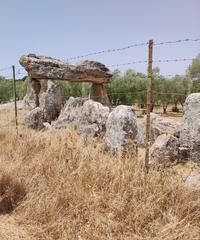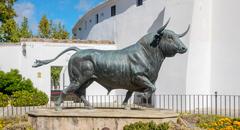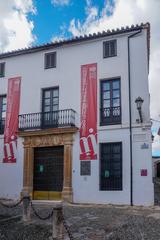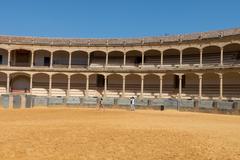Columnaria Romana de la Torre del Predicatorio: Visiting Hours, Tickets, and Travel Guide in Ronda, Spain
Date: 14/06/2025
Introduction
Nestled in the heart of Ronda, Spain, the Columnaria Romana de la Torre del Predicatorio stands as a vivid reminder of the city’s storied Roman past. This remarkable archaeological site, comprising ancient Roman columns and the adjacent medieval Torre del Predicatorio, offers visitors a unique perspective into the urban ingenuity, architectural excellence, and cultural evolution that have defined Ronda across centuries. Whether you are a history enthusiast, architecture admirer, or curious traveler, this comprehensive guide provides all the essential information for planning your visit, including historical background, ticketing, accessibility, nearby attractions, and practical travel tips.
For up-to-date details and immersive exploration, resources such as the official Ronda Tourism website and audio guides like Audiala are invaluable companions on your journey through Ronda’s Roman heritage (Ronda Today; Museo Municipal de Ronda).
Table of Contents
- Roman Settlement and Urbanization in Ronda
- The Role and Significance of the Columnaria Romana de la Torre del Predicatorio
- Architectural Features and Construction Techniques
- Integration into the Roman Urban Grid
- Socio-Economic Importance
- Transformation Through the Ages
- Archaeological Discoveries and Preservation
- Visiting Information: Hours, Tickets, and Accessibility
- Travel Tips and Nearby Attractions
- Frequently Asked Questions (FAQ)
- Conclusion and Final Travel Advice
- References and Further Reading
Roman Settlement and Urbanization in Ronda
Ronda’s origins trace back to the 2nd century BCE, when it emerged as Arunda under Roman rule following the conquest of the Iberian Peninsula. The city was strategically established atop a high plateau, providing natural defenses and commanding views of surrounding valleys and trade routes. This prime location fostered economic prosperity, cementing Ronda’s role as a key settlement in Hispania Baetica (Ronda Today).
Roman urban planning principles were meticulously implemented, with the city organized along a grid of main streets intersecting at the forum—the hub of civic life. This layout facilitated both movement and commerce, reflecting the broader Roman approach to urbanization.
The Role and Significance of the Columnaria Romana de la Torre del Predicatorio
The Columnaria Romana de la Torre del Predicatorio is a striking testament to Ronda’s Roman heritage. The colonnade—featuring Corinthian and Ionic capitals—and the adjoining Torre del Predicatorio likely marked an important civic or ceremonial space, possibly near the ancient forum or a temple precinct. Archaeological and historical evidence points to the tower’s role as a key hydraulic structure within the Roman aqueduct system, regulating and distributing water to the city.
The Torre del Predicatorio itself, dating from the medieval period, was constructed atop earlier Roman foundations. This architectural layering highlights Ronda’s continuous urban occupation and cultural evolution, seamlessly blending Roman, Islamic, and Christian influences (Museo Municipal de Ronda).
Architectural Features and Construction Techniques
The Columnaria Romana is renowned for its finely crafted limestone and sandstone columns, fluted shafts, and classical capitals. These elements once supported covered walkways or porticoes, offering shelter and enhancing the civic environment. Roman engineering expertise is evident in the use of ashlar masonry, lime mortar, and precise geometric alignment, adhering to the principles established by Vitruvius.
The Torre del Predicatorio showcases robust medieval construction, utilizing both large stone blocks and smaller masonry in its walls. Within the tower, remnants of Roman ceramic piping and water channels reveal its function as part of an advanced hydraulic system, including a siphon to manage the steep terrain (Junta de Andalucía PDF).
Integration into the Roman Urban Grid
The Columnaria Romana was likely situated along one of Ronda’s primary Roman thoroughfares, close to the forum and other essential public spaces. The colonnaded streets not only facilitated commerce and transportation but also served as venues for social interaction and public gatherings, reflecting the prosperity and Romanization of the city.
Socio-Economic Importance
Monumental projects like the Columnaria Romana were funded by local elites eager to demonstrate loyalty to Rome and invest in their city’s future. These structures became focal points for markets, legal proceedings, and religious ceremonies, shaping daily life in Arunda. Archaeological finds, including inscriptions and coins, attest to the thriving municipal administration and the enduring impact of Roman civic ideals (Ronda Today).
Transformation Through the Ages
With the fall of Roman authority, Ronda underwent significant changes. The city’s Roman infrastructure was adapted by Visigothic and later Islamic rulers, who integrated the ancient columns and hydraulic systems into new urban layouts. The reuse of Roman architectural elements in medieval mosques, palaces, and fortifications underscores the lasting influence and prestige of classical design. The Torre del Predicatorio itself is a medieval addition that stands as a testament to this ongoing process of adaptation.
Archaeological Discoveries and Preservation
Ongoing excavations have uncovered Roman pottery, coins, inscriptions, and nearly 50 meters of original ceramic piping near the tower, offering invaluable insight into ancient engineering and daily life. Conservation efforts, led by local authorities and the Junta de Andalucía, focus on stabilizing the ruins, providing interpretive signage, and integrating the site into Ronda’s broader historical narrative (Wanderlog).
Community engagement, volunteer programs, and educational workshops foster a sense of stewardship, ensuring the site is preserved for future generations (Jornadas Europeas de Patrimonio).
Visiting Information: Hours, Tickets, and Accessibility
Visiting Hours:
- Most sources report the site is open daily from 9:00 AM to 6:00 PM, with last entry at 5:30 PM.
- Hours may vary seasonally and for special events; always check the official Ronda Tourism website before visiting.
Tickets:
- Entry is generally free for the open-air site, but some guided tours or combined archaeological tickets may range from €5 for adults, with discounts for seniors, students, and free admission for children under 12.
- Tickets can be purchased on-site or online, especially for guided tours and combined experiences.
Accessibility:
- Smooth pathways and ramps provide partial wheelchair access, though some uneven terrain and cobblestones may present challenges.
- Contact the Ronda Tourist Office for the latest accessibility information.
Guided Tours:
- Local operators and the Museo Municipal de Ronda offer guided tours, often including the tower and other Roman sites, starting from €10 per person.
Facilities:
- Restrooms and a small visitor center with exhibits are located nearby; cafés and restaurants are within walking distance in Ronda’s historic center.
Travel Tips and Nearby Attractions
- Getting There:
The site is located near Calle Armiñán in Ronda’s old town, a short walk from major landmarks such as the Puente Nuevo and Plaza de Toros. The RENFE train station is 1.5 km away, with taxis and local buses available (RENFE). - Parking:
Public parking is available at Parking Plaza del Socorro and Parking El Castillo (Parkopedia: Ronda). - Nearby Attractions:
- Puente Nuevo: Iconic 18th-century bridge over El Tajo gorge
- Plaza de Toros: One of Spain’s oldest bullrings
- Baños Árabes: 13th-century Moorish baths
- Museo Municipal de Ronda: Local history museum
- Best Times to Visit:
April–June and September–November for pleasant weather and fewer crowds; early morning or late afternoon for the best light and quietest experience.
Frequently Asked Questions (FAQ)
Q: What are the visiting hours?
A: Daily from 9:00 AM to 6:00 PM (last entry 5:30 PM); hours may vary—check the official website.
Q: Is there an entrance fee?
A: Entry is usually free for the open-air site; guided tours or combined tickets may have a fee.
Q: Is the site accessible for wheelchair users?
A: Partial accessibility; uneven terrain and cobblestones may require assistance.
Q: Can I join a guided tour?
A: Yes, book through local operators or the Museo Municipal de Ronda.
Q: What other attractions are nearby?
A: Puente Nuevo, Plaza de Toros, Baños Árabes, and the Museo Municipal de Ronda.
Q: Is photography allowed?
A: Yes, but drones and tripods require prior permission (Ayuntamiento de Ronda).
Conclusion and Final Travel Advice
The Columnaria Romana de la Torre del Predicatorio is a must-see for anyone exploring Ronda’s rich tapestry of history. Its Roman columns and medieval tower encapsulate centuries of architectural evolution and cultural transformation. With free or affordable entry, a convenient central location, and close proximity to other major attractions, the site offers an enriching and accessible experience for visitors of all interests.
For the best experience, visit during spring or autumn, consider joining a guided tour, and utilize digital resources like Audiala for in-depth audio guides. Always respect the site’s integrity, support local businesses, and check official resources for current information.
References and Further Reading
- Ronda Today
- Museo Municipal de Ronda
- Wanderlog
- Ronda Tourism
- Junta de Andalucía PDF
- Responsible Tourism in Spain
- RENFE
- Parkopedia: Ronda
- Jornadas Europeas de Patrimonio
- Andalusian Heritage Inventory



